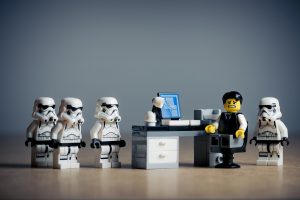Editor’s Note: Kayleigh Alexandra is a writer and campaign designer for MicroStartups, a website focused on charities and microbusinesses. Her opinions are her own.
Once something easily written off as a frivolous vanity exercise, internal branding has steadily morphed into something that top businesses are paying very close attention to (and funding in quite interesting ways) — something with inarguable real-world consequences when it comes to attracting the best candidates and optimizing employee performance.
If you’re fully committed to making your company an appealing destination for top talent, then you should clearly give some thought to how you might build an internal brand that can draw in prospective hires. How should your staff members think and speak of your company? Should you set out company values? What should it feel like to work for you?
When figuring this out, you could painstakingly workshop the matter from scratch. That would be bold, and inventive, yes — but mostly obscenely wasteful given all the time and effort that the aforementioned businesses have put in throughout the years. Instead, I suggest that you look to the trendsetters for inspiration. Having gleaned some insight from how they conduct business, you can then throw in your original perspective to create an internal brand that’s truly yours.
To that end, we’re going to take a look at 5 sizable companies that have put a lot time into internal branding, picking out what lessons they can teach us. Let’s begin:
FedEx
The lesson: incentivize exceptional performance.
As a multinational delivery service (and one of the most recognizable in the world), FedEx has a lot on its plate, and a lot of employees (with over 350,000 staff members, it’s actually in the top 10 of US employers). And given that customers are often locked into using certain couriers because of the limited options available to them, it could probably get away with taking a relaxed approach to service, so it’s notable that it pointedly goes in the other direction.
FedEx champions what it calls the Purple Promise, which goes like this: “I will make every FedEx experience outstanding.” It details the specifics in this booklet, and the part that sticks out most to me is the advocacy of “thinking beyond our individual roles to find the best solution” — no matter the role of an employee, or what specifically they’ve been told to do, they’re implicitly supported in taking special steps to exceed expectations.
And this isn’t simply something to which the company pays lip service. It’s something that gets identified and recognized when it takes place: the employee responsible gets praise, a shot at the Purple Promise Award, and often some publicity in the form of a PR-friendly story. It’s also reflected in the variable pay compensation scheme — exceptional performers earn more. If you make exceptional performance a core goal of your brand, you can get every staff member working harder and feeling more satisfied with their role.
Starbucks
The lesson: create a shared ideal.
Starbucks has really cornered the immensely-lucrative coffee market. You know that a company has excelled when it can reach the point of attracting widespread criticism for supplanting local businesses but quickly emerge unscathed because people enjoy its products so much. Everywhere you go, there’s a Starbucks, and there’s a big reason for this.
What is it? Well, central to the company’s ethos is a belief in something: an ideal of what every Starbucks should mean to people, of what it must mean to people. While serving as the company’s VP of Brand Planning, Jerome Conlon put a lot of work into bringing company employees together to discuss the individual ideas of what the business meant, and subsequently identifying a vision that everyone could share.
Discussing his efforts in an interview with Branding Strategy Insider, Conlon noted the following: “This new brand vision talk was given a name: Starbucks – The New Third Place. It’s not home (1st place) or work (2nd place) it’s somewhere in between, a public hang out.” This vision stuck. Now, every Starbucks manager knows exactly what vibe they’re aiming for, and finding ways to achieve it gives them greater job satisfaction.
Ultimately, if you can create an ideal that everyone in your business can believe in and strive towards, you can create a collaborative team atmosphere that will make every role you fill feel more purposeful — and more significant.
Shopify
The lesson: drive company-wide connection.
Playing a central role in the massive rise of online retail entrepreneurs, Shopify has grown from a small Ottawa startup to a huge provider of scalable store hosting that works at an enterprise level and even supports international sellers — and core to that growth has been a strong commitment to squeezing all the creative juice from every member of staff.
Consider how competitive and fast-moving the tech industry is. Rolling out a new feature before your competitors can get it off the ground — even if you’re only ahead by a fraction — can make all the difference, and it’s worth scouring through 100 mixed ideas to pick out the 1 that might be capable of changing the game.
In this 2015 interview, Brittany Forsyth, Shopify’s VP of Human Relations, spoke about the Shopify culture. What sticks out to me is how seriously they take the concept of bringing people from different parts of the company together, even creating an internal app to do just that:
“(Lunchify) […] automatically pairs two employees up for lunch every week or month (depending on their setting). […] The app sends you an email with a link to the person you’ll be having lunch with. You can check out their profile in our internal portal, Vault, to get an idea of their background, role and interest and then you find them in the lunch line and the rest is history.”
Part of your internal brand should be a determination to get everyone involved in determining the overall direction of the company, instead of leaving it all to a handful of managers. Get people talking, and they just might have powerful contributions to make.
Netflix
The lesson: encourage people to make mistakes.
Netflix is a streaming phenomenon, now producing an astonishing amount of original content and increasing viewing figures that make the decline of legacy media more glaringly apparent. Originally a service for sending rented movies through the mail, it pivoted, and when Blockbuster famously passed up the chance to buy it, the death knell of traditional media rental was sounded.
You can say that it was in the right place at the right time, sure, but that can’t entirely account for its meteoric rise. Something else that’s played a significant role is the company’s ongoing commitment to embracing failure — trying new things to see if they work, then learning some lessons and moving on if they don’t.
In this 2018 interview with The Drum, Jessica Neal, the Chief Talent Officer at Netflix, explained this part of the business: “We’re not afraid to fail; it’s all about learning. If we get down a path that we think is the wrong way, we can easily turn around and change it.” What’s more, this isn’t simply something they claim: it’s also noted in the interview that chief executive Reed Hastings makes an effort to lead by example by freely discussing his failures.
Core to your brand, then, should be tempered freedom to try new things, even if you’re not sure that they’ll work. Knowing that they’ll have the opportunity to get things wrong and learn from them will make your employees feel a lot more relaxed, supported, and creatively fulfilled.
Virgin Media
The lesson: make low-level employees feel special.
Virgin Media is a company that encompasses a lot of distinct departments, but a unifying demand is that of customer support. With TV, phone and internet services inevitably picking up a lot of technical queries and complaints, it’s necessary to maintain a huge set of customer support assistants throughout numerous call centers.
The tricky thing about this is that working in a call center is near-universally acknowledged as an energy-draining experience. Workers get yelled at, criticized, and expected to achieve miracles far beyond their organizational remits — and if they’re treated as expendable, with nothing done to prevent them from developing low morale, the companywide consequences are dire.
In an interview with Discover Global, Simon Jeffers, a Project Communications & Engagement Design Manager at Virgin Media, stated the following: “We recognise that it’s really hard to get a good work/life balance so we introduced Virgin Angels to our UK and Off-Shore call centres. Our Angels are there for our people to ensure they can take on the tasks that sometimes distract us from giving a great customer service.”
Knowing that the lowest-level employees are still crucial to the business, Virgin Media makes a habit of regularly sending teams to support them by providing good food, helping with admin, and generally finding ways to make the everyday working environment more bearable. Your brand should make a similar commitment: that everyone in your business, no matter their seniority or station, deserves care and attention.
Each of these 5 companies have spent a lot of money on developing internal branding, so you can’t realistically expect to come anywhere close to their levels of polish — but you can draw from their approaches fairly cheaply and easily. Try applying these lessons to your business, and see how your employees react. It might be exactly what you need to become a destination employer.
If you want to get ahead with internal branding, it’s worth leaning on technology to do so. Check out this guide for using technology for brand market research to get started.

















